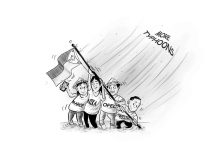BY SAMMY JULIAN
DESPITE claims of an impressive growth rate, the Aquino administration seems to have failed to address the country’s high unemployment rate.
According to a recent survey, the number of jobless adult Filipinos hardly changed at 25.9 percent, or 11.8 million in the second quarter of this year.
The Social Weather Stations (SWS) survey conducted among 1,200 adults nationwide from June 27 to 30 showed that it is slightly lower than the 26.1 percent jobless rate in the same period last year.
The SWS said adult joblessness has been above 20 percent since May 2005, except when it was 19.9 percent in March 2006, 17.5 percent in December 2007 and 18.9 percent in September 2010.
It noted that in the SWS data series – which began in 1993 – joblessness was below 15 percent until March 2004. It ranged from 16.5 percent to 19 percent from August 2004 to March 2005, and has since then stayed above 20 percent.
The record high in the 20 years that the SWS has been conducting the survey is 34.2 percent, registered in February 2009.
At the same time, optimism on job availability fell by 10 points to a “mediocre” +3 (percent more jobs minus percent fewer jobs) from the “fair” +13 recorded in the first quarter.
Thirty-two percent (from 36 percent in the first quarter) of respondents said the number of available jobs in the next 12 months will increase, 29 percent (from 32 percent) said it would stay the same, and 28 percent (from 23 percent) believe the number of positions available would decrease.
Adult joblessness in the latest survey was broken down into those who voluntarily left their old jobs (13.2 percent, up 1.8 points from March), were retrenched (8.8 percent, down 1.9 points), and first-time job seekers (3.6 percent, barely changed from 3.3 percent).
Broken down further, those retrenched consisted of 6.3 percent whose contracts were not renewed, one percent whose employers ended operations and 1.5 percent who were laid off.
“Adult joblessness has traditionally been dominated by those who voluntarily left their old jobs and who lost their jobs due to economic circumstances beyond their control,” SWS noted.
By gender, SWS said joblessness among women rose by 2.1 points to 39.9 percent, the highest since the 42.5 percent recorded in August 2012, while joblessness among men fell 1.8 points to 14.7 percent, the lowest since the 14.3 percent recorded in June 2011.
By age group, joblessness “rose sharply” by 19.4 points among the youth – or those 18 to 24 years old – to 62.8 percent in the second quarter, the highest since the 63.3 percent recorded in June 2008, SWS said.
Joblessness was also up among those aged 25 to 34, by 4.7 points to 35.2 percent, the highest since the 45.4 percent recorded in March 2012. It was down among those aged 35 to 44 by 12.6 points to 12.9 percent in June, the lowest since the 11.5 percent in September 2010, and “hardly changed” among those aged 45 and above at 16.7 percent in the second quarter from the 16.5 percent in the first quarter.
Asked about their expectations for the next 12 months, respondents who said there will be more jobs fell four points to 32 percent. Those who said there will be fewer openings rose five points to 28 percent, while those who said there will be no change in job availability fell three points to 29 percent.
SWS’ definition of joblessness differs from the government’s unemployment measure. SWS respondents are at least 18 years old compared to the government’s minimum age of 15.
Moreover, for SWS, persons with jobs are those currently working, including unpaid family members.
Joblessness, the SWS added, is based on two traditional qualifications: without a job at present and looking for a job. Hence, those not working but not looking for a job – such as housewives, retirees and students – are excluded.
The government’s Labor Force Survey, on the other hand, uses three criteria to identify the unemployed, namely: not working, looking for work, and available for work.
Hence, those not available for work – even though they were looking for a job – are excluded, while those available for work but were not seeking it (for reasons like illness or waiting for results of a job application) are included.
Applying the government’s availability criteria, SWS said joblessness among adults in the second quarter was 15.2 percent, equivalent to an estimated 6.1 million Filipinos.
The June survey had sampling error margins of ±3 percent for national percentages as well as ±6 percent for Metro Manila, “Balance Luzon,” Visayas and Mindanao.
So what does the government say about this?
Well, what can we expect the standard answer.
“The government continues to pursue job creation strategies that will provide more highly remunerative employment,” said Communications Secretary Herminio B. Coloma Jr.
The Aquino administration has less than two years remaining. If it fails to address the high unemployment rate during its first four years, will it be able to solve the problem in the last two?/PN



